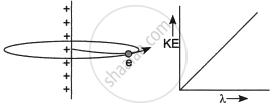Advertisements
Advertisements
Question
Draw a graph of kinetic energy as a function of linear charge density λ.
Solution
The graph is shown below.
(a straight line passing through the origin)

APPEARS IN
RELATED QUESTIONS
A 36 cm long sonometer wire vibrates with frequency of 280 Hz in fundamental mode, when it is under tension of 24.5 N. Calculate linear density of the material of wire.
"For any charge configuration, equipotential surface through a point is normal to the electric field." Justify.
Electric intensity outside a charged cylinder having the charge per unit length 'λ' at a distance from its axis is ________.
(a) E = `(2pi in_0 lambda)/(Kr^2)`
(b) E = `(in_0 lambda)/(2piKr^2)`
(c) E = `lambda/(2piin_0Kr)`
(d) E = `(4piin_0lambda)/(Kr^2)`
Use Gauss' law to derive the expression for the electric field `(vecE)` due to a straight uniformly charged infinite line of charge density λ C/m.
Find the work done in bringing a charge q from perpendicular distance r1 to r2 (r2 > r1)
A spherical ball contracts in volume by 0.02% when subjected to a pressure of 100 atmosphere. Assuming one atmosphere = 105 Nm−2, the bulk modulus of the material of the ball is:
What is the nature of the Gaussian surface involved in the Gauss law of electrostatics?
Sketch the electric field lines for a uniformly charged hollow cylinder shown in figure.

Consider a sphere of radius R with charge density distributed as
ρ(r) = kr for r ≤ R
= 0 for r > R
- Find the electric field at all points r.
- Suppose the total charge on the sphere is 2e where e is the electron charge. Where can two protons be embedded such that the force on each of them is zero. Assume that the introduction of the proton does not alter the negative charge distribution.
A solid metal sphere of radius R having charge q is enclosed inside the concentric spherical shell of inner radius a and outer radius b as shown in the figure. The approximate variation of the electric field `vecE` as a function of distance r from centre O is given by ______.

